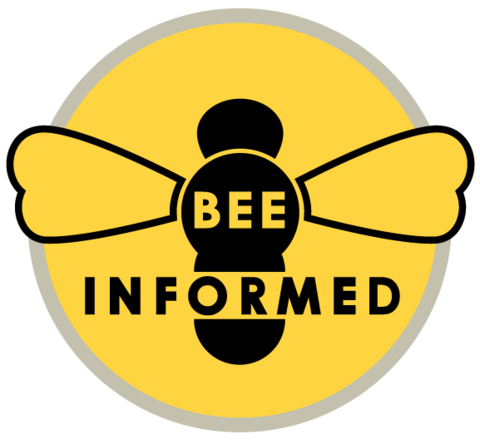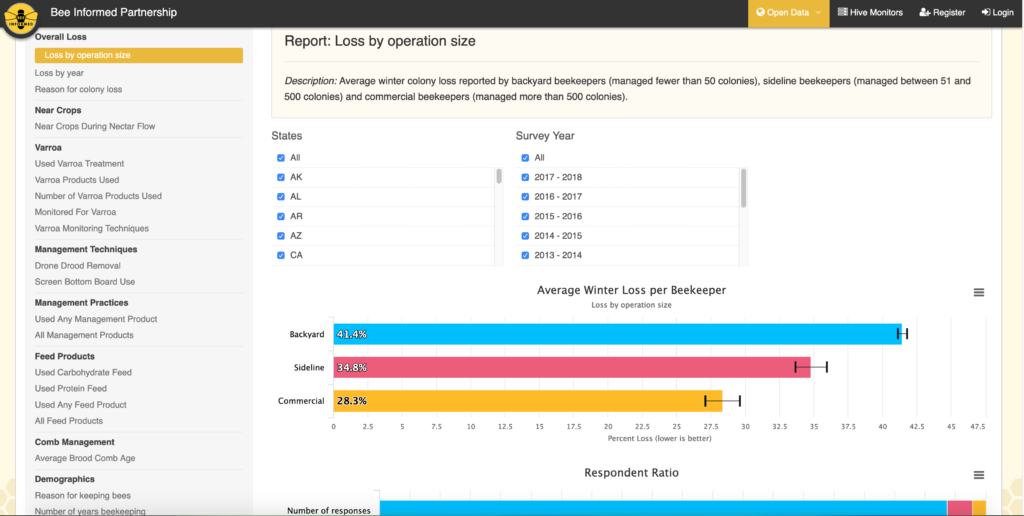

Digging through Bee Informed Partnership (BIP)
open National Management Survey data.
Vera Strogolova, CTO, Strong Microbials Inc.
Workshops on how to use the Bee informed Partnership’s Survey data would benefit beekeepers. This April as the 2018-2019 results start to come in, it is important to understand how to utilize the BIP data as an objective way to prepare for the season by seeing which beekeeping practices work. The information is open, it’s good to learn how to use it.
Use this website (https://bip2.beeinformed.org/survey/ ) to access the data.

To begin, take a look at the Bee Informed Partnership National Management Survey results window. On the left hand side, beekeepers can select from 25 different options. These include management options, Varroa treatments, Feed products, Queen management. Then in the right hand side, these options can be narrowed down to specific states, beekeeping operation size, and years.
Reports can be generated to evaluate selected product(s). For example, among All Feed Products, one can scroll down to select “Microbials” and see how they fare. Microbials is a new term that was included for the first time in 2017-2018 survey. Microbial products encompass a number of different probiotic, or direct fed microbial (DFM) products. Try selecting all states, all types of beekeepers and 2017-2018 survey year (Figure 1). At the time I’m writing this, the beekeepers who use microbials report 20.7% loss on average, much below the national average.

Figure 1. Screenshot of the Bee Informed Partnership’s website where beekeepers can explore many years’ worth of data. In this example, data is filtered to see the effect of Microbials on survival (of All Feed Products) in 2017-2018 survey year
Another example is to generate a report comparing losses by operation size (mentioned in Bee Culture, April 2019 issue, p. 42-44). Commercial beekeepers who manage more than 500 colonies, have lower losses compared to national average, which includes all beekeepers: backyard, sideliner, and commercial. Commercial beekeeper losses stay the same or decrease compared to previous years, reflecting improved and refined beekeeping practices and management (Figure 2). Commercial beekeeper losses provide a meaningful economic evaluation of different management practices and medications, for example Amitraz, Fumagillin, Terramycin, Tylan.
| 2013 | 2014 | 2015 | 2016 | 2017 | |
| #responses (n) | 152 | 123 | 93 | 98 | 93 |
| # colonies | 847 K | 616 K | 571 K | 656 K | 446 K |
| % loss, winter | 30.7% | 22.7% | 25.3% | 25.6% | 25.6% |

Figure 2. Commercial beekeeper annual colony losses over 5 years. National Management Survey data https:/bip2.beeinformed.org/ accessed March 1, 2019.
The use of antibiotics is consistently high among commercial beekeepers (Figure 3). Majority of commercial beekeepers used both Terramycin and Tylan, antibiotics available by prescription. This is unfortunate because antibiotic-induced dysbiosis adds to the problems that bees experience now. Hopefully with more data collected, and more beekeepers looking into it to see what works, we will be able to take our bees off antibiotics. The tables below reports % colony loss by commercial beekeepers (n=number of beekeepers):
| 2013 | 2014 | 2015 | 2016 | 2017 | |
| used Terramycin | 29.7% (n=87) | 22.3% (n=88) | 20.5% (n=59) | 24.3% (n=72) | 25.4% (n=73) |
| did not use Terramycin | 32.3% (n=38) | 25.3% (n=16) | 37.6% (n=12) | 28.0% (n=6) | 19.9% (n=5) |
| 2013 | 2014 | 2015 | 2016 | 2017 | |
| used Tylan | 29.8% (n=81) | 22.9% (n=87) | 23.0% (n=64) | 24.6% (n=73) | 25.1% (n=70) |
| did not use Tylan | 31.7% (n=44) | 22.4% (n=17) | 27.3% (n=7) | 24.3% (n=5) | 24.5% (n=8) |
Figure 3. Influence of Terramycin and Tylan on commercial beekeepers average beekeeper colony loss. National Management Survey, https:/bip2.beeinformed.org/ accessed March 25, 2019
Commercial beekeepers using Amitraz reported lower colony losses than those who did not use Amitraz. Clearly, additional factors besides Amitraz treatment influence colony loss. Even as use of Amitraz became more widespread, in 2016 and 2017 colony losses increased among beekeepers using Amitraz (Figure 4). Increased colony loss in beekeepers using Amitraz alone reflects the increasing use of more than one varroacide treatment in many operations. Majority of beekeepers used 2 or more different Varroa products (Figure 5). Research of best varroa management practices is vitally important.
| 2013 | 2014 | 2015 | 2016 | 2017 | |
| used Amitraz | 28.2% (n=69) | 21.9% (n=76) | 20.4% (n=58) | 24.5% (n=71) | 25.3% (n=69) |
| did not use Amitraz | 33.3% (n=56) | 25.1% (n=28) | 36.9% (n=13) | 25.5% (n=7) | 23.2% (n=9) |

| # varroa products used | 2013 | 2014 | 2015 | 2016 | 2017 |
| 0 products | 27.5% (n=13) | 11.7% (n=5) | N/A (n<5) | N/A (n<5) | N/A (n<5) |
| 1 products | 31.1% (n=55) | 22.2% (n=29) | 21.6% (n=25) | 23.5% (n=28) | 18.6% (n=25) |
| 2 products | 32.5% (n=33) | 26.4% (n=33) | 25.1% (n=18) | 23.8% (n=25) | 27.4% (n=27) |
| 3+ products | 27.7% (n=24) | 21.5% (n=37) | 21.0% (n=26) | 24.8% (n=24) | 28.7% (n=26) |
Figure 5. Colony loss among commercial beekeepers using known varroa products alone or in combination. National Management Survey, https:/bip2.beeinformed.org/ accessed March 25, 2019.
In contrast to increasing use of Amitraz, in 2016 and 2017 most commercial beekeepers did not use Fumagillin (Figure 6). The data shows that among commercial beekeepers, the use of Fumagillin became less widespread long before its production stopped in 2018. Commercial beekeepers who did not use Fumagillin as Nosema treatment reported lower colony losses. This information is helpful to those seeking non-Fumagillin prevention and control of Nosema infection. While Nosema spore count shows seasonality, Nosema infection is a major cause of colony loss. As the results of 2018 National surveys start to come in, a new variable included in the Survey is the use of microbial products such as SuperDFM-HoneyBee. Strong Microbials has been studying the effect of SuperDFM-HoneyBee on Nosema for years.
| 2013 | 2014 | 2015 | 2016 | 2017 | |
| used Fumagillin | 30.6% (n=41) | 21.7% (n=49) | 21.9% (n=34) | 26.6% (n=28) | 26.1% (n=29) |
| did not use Fumagillin | 30.4% (n=84) | 23.8% (n=55) | 24.7% (n=37) | 23.5% (n=50) | 24.4% (n=49) |

